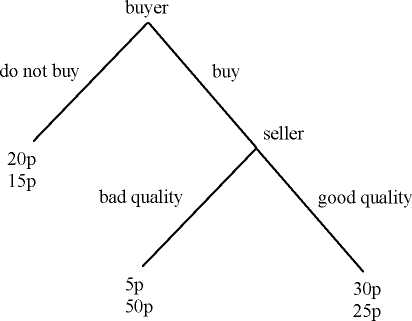Comparing the different network treatments we then establish this note’s main result—that
market performance is increasing in network density. This increase in efficiency has two
causes. Moving from DEGENERATE to PARTIAL we find that buyers are significantly more
likely to trust sellers (that is, demand increases) while the average quality of traded goods
stays constant. Moving from PARTIAL to FULL we find that, while demand stays constant,
there is a significant rise in average quality.
2 Experimental design and procedures
To study how network density influences market performance we consider a binary-choice
trust game with two players1 as shown in Figure 1. Here, the buyer (first mover) decides
whether or not to buy an experience good and the seller (second mover) whether or not to
deliver good quality. The chosen payoffs reflect a conflict of interest. While the buyer always
prefers good over bad quality (30 > 5), the seller has a strict preference to sell bad quality (50
> 25). In addition, the buyer prefers not to buy over getting bad quality (20 > 5) and the seller
would rather provide good quality than not selling at all (25 > 15). Assuming that subjects
maximize their own monetary income, the game has a unique Nash equilibrium in which the
buyer does not buy and the seller provides bad quality if someone shops from him.
Figure 1: The trust game

1 In the experiment we adopt neutral language, e.g. a buyer is labeled A; seller - B; do not buy - X; buy - Y; etc.
See Appendix for instructions.
More intriguing information
1. Growth and Technological Leadership in US Industries: A Spatial Econometric Analysis at the State Level, 1963-19972. The name is absent
3. Comparative study of hatching rates of African catfish (Clarias gariepinus Burchell 1822) eggs on different substrates
4. Spectral density bandwith choice and prewightening in the estimation of heteroskadasticity and autocorrelation consistent covariance matrices in panel data models
5. The name is absent
6. The name is absent
7. Estimating the Technology of Cognitive and Noncognitive Skill Formation
8. Wettbewerbs- und Industriepolitik - EU-Integration als Dritter Weg?
9. The name is absent
10. Does Competition Increase Economic Efficiency in Swedish County Councils?